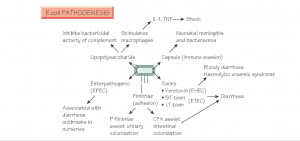|
My research is primarily concerned with secondary pathogens of the respiratory tract. Pseudomonas aeruginosa, has been of particular concern because of the high mortality rates associated with hospital-acquired infections and the high incidence in cystic fibrosis patients. More recently we have expanded our interests to other Gram-negative bacteria.
Recent investigations have concerned identification of the receptors on eukaryotic cells for bacteria. The primary interest has been identification of receptors for Pseudomonas aeruginosa. Two classes of receptors have been identified. We are currently trying to identify the bacterial adhesins responsible for the binding. At least two adhesins have been characterized: pili and flagella. The role of pili has been documented by several investigators. How flagella may function as an adhesin is less clear, but our results indicate that it is required for adherence. We have hypothesized that after the organisms have attached to cells by contractile pili, they are brought to the cell surface where secondary adhesins create a stronger attachment. Flagellin appears to be a major secondary adhesin.
An exciting finding that may be related to the targeting of the flagellin is posttranslational modification of flagellin. A segment of DNA located downstream of the flagellin gene appears to be involved in the modification of flagellin. This process is distinct from the phosphorylation of flagellin that has been noted by others, and may involve glycosylation–a rare event in bacteria. The regulation and significance of the modificationare a major areas of focus.
An new area of investigation is genetic immunization to prevent the occurence of secondary infection following traumatic injury. Preliminary data using the P. aeruginosa flagellin gene in a eucaryotic expression system indicates that we can induce a strong immune response to bacterial antigens following injection of the plasmid DNA. Current studies are concentrating on defining the optimum conditions for immunization and determining the efficacy of these vaccines. |

Baker, N. and Verran, J. (2004). The future of Microbiology Laboratory Classes: Wet, dry or in combination. Nature Rev. Microbiol. 2 :338-342.
Denis-Mize KS, Price BM, Baker N.R., Galloway DR. 2000. Analysis of immunization with DNA encoding Pseudomonas aeruginosa exotoxin A. FEMS Immunol Med Microbiol. 27:147-54.
Wahl, S. and Baker, N.R. Identification of a locus involved in the posttranslational modification of flagellin from Pseudomonas aeruginosa. Molecular Microbiology – In preparation
Wahl, S. and Baker, N.R. Analysis of type a flagellin from Pseudomonas aeruginosa strain PAO1. In preparation.
Baker, N.R., Gehring, K. and Wahl, S. Evidence for a direct role of flagellin in the adherence of Pseudomonas aeruginosa to glycosphingolipids. In preparation.
Baker, N. R. 1992. Mucosal adherence of Pseudomonas aeruginosa. In R.B.Fick (ed.), Pseudomonas aeruginosa the opportunist: pathogenesis and disease. CRC Press, Inc.
Baker, N.R., V. Minor, C. Deal, M.S. Shahrabadi, D.A. Simpson, and D.E.Woods. 1991. Pseudomonas aeruginosaexoenzyme-S is an adhesin. Infect.Immun. 59:2859-2863.
Baker, N. R. 1991. The role of exoenzyme-S in the adherence of Pseudomonas aeruginosa. Pediat. Pulmon. S6: 136-137.
Baker, N.R., G. Hansson, H. Leffler, G. Riise, and C. Svanborg-Eden. 1990.Glycosphingolipid receptors for Pseudomonas aeruginosa. Infect. Immun.58:2361-2366 |

